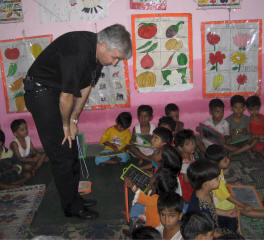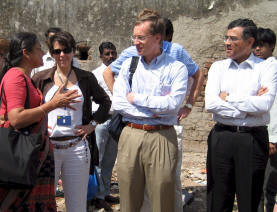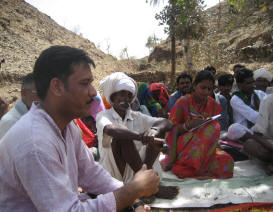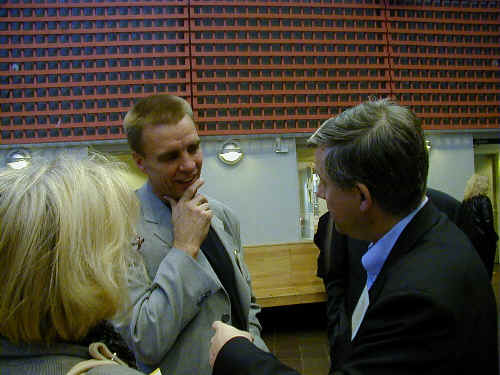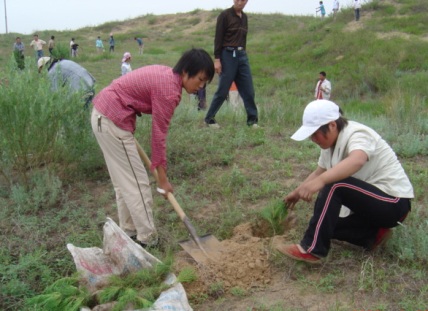Rinkeby Skolan is a school on the outskirts of
Stockholm, Sweden. It is an example of the types of challenges facing
European cities as they find ways to deal with immigrant populations and
prepare young people for the future of Europe.
Rinkeby is a suburb of Stockholm with 13,000
inhabitants largely of immigrants to Sweden. Those living there represent
some 62 countries, speak 30 different languages and are of many different
ethnic groups and religions. Half the population is Muslim.
Twelve years ago, this community was a testimony to
failure. Unable to resolve differences, to deal with crime or to ensure an
education for the future of their children, 30% of its residents moved in
and out of Rinkeby on an annual basis. Its school was a dangerous place to
be, poorly maintained and covered with graffiti. Politicians were ready to
close it down and to send the children to schools in other communities.
The situation was so bad it had to improve, and it did.
When Börje Ehrstrand was offered the position of
Rektor (Headmaster) of Rinkeby Skolan he said,
"This
is the best job you can take in Sweden as a headmaster. Everything is
going to change and improve."
Twelve years later in 2002, the community of Rinkeby
has one of the best schools in Sweden and possibly one of the best public
schools in Europe. Its students learn to speak a minimum of four languages
and often several more. It has the best sports teams of any school in
Sweden. Ninety-seven percent of its students graduate. Twelve years ago it
was less than half. Rinkeby Skolan received the European prize for the
best in prevention of crime.
How was this accomplished?
Mr. Ehrstrand believes that "the way to
change a school is to take the parents into the school." He says,
"you must ask them what they want for the future." As
immigrants from many countries, they want their children to be prepared
for a future in Europe as a whole, not just in Sweden or the town in which
they live.
Here was the seed for an idea that made Rinkeby
Skolan special in the way it prepares its students for the future Europe.
There was much to do. Vandalism was rampant; graffiti was everywhere;
parents had no confidence in the school and feared for their children’s
safety because of crime.
Mr. Ehrstrand saw parents as the key resource for
changing the school and knew that their support and involvement was
essential. When he called the first meeting, 200 parents attended and were
informed by the headmaster that the school could not improve without their
help. The teachers could not do it alone.
Parents, children and teachers took responsibility
for removing the graffiti and improving the physical condition of the
school. Local residents who were carpenters and others gave their time to
help rebuild the school. The children took responsibility for cleaning the
halls, removing the graffiti, cleaning toilets, removing chewing gum and
painting.
Each year the School receives funding from the
government based on a set amount per student. Rather than use this to
repair and maintain the buildings, Mr. Ehrstrand and the School choose to
spend the money on culture and sports while relying on the students
themselves and the community to maintain the physical condition of their
school. The students continue to clean the school, including the toilets.
It is understood that "if students learn
to take responsibility for the condition of their school, they will have a
similar attitude and behavior in their community".
The Rinkeby School has 480 students; 20% of them
live outside the Rinkeby suburb. In Sweden, parents may choose which
school to send their children, even if it is outside the community in
which they live. The educational objective of Rinkeby Skolan is to give
all children the maximum of education related to their own ability. As the
student body at Rinkeby Skolan represents some 62 countries, 30 different
languages and many religions, it is a microcosm of the future of Europe.
Unlike their parents, these children are likely to live and move in
different places in their lives. They must learn how to integrate not only
into Sweden, which is a country of seven million people, but also into a
multicultural and increasingly divers Europe of the future. They represent
Europe’s future.
Students of the School may follow one of two paths
in their education and development. The first of these is European studies
where it is expected that 100% will go on to higher education in
universities. The second is focused on science and nature and is conducted
in partnership with technical institutions. Students typically go on to
technical colleges where they are prepared with working skills for their
careers.
The School requires each student to develop a
three-part plan for:
(1) acquiring a high level of knowledge;
(2) developing social confidence with different
groups and nationalities as good members of society capable of handling
their future;
(3) achieving good physical and mental health. All
students have mentors in pursuing their development.
Students must learn to communicate in four
languages. The School believes that it is possible to learn three
languages at the same time at the age of three. At ten years old, students
choose their fourth language and at thirteen years, they have the option
of the fifth language or more.
Those who follow European studies must learn
Swedish, but they must also learn to speak and write their native language
because they will work in the Europe of the future. At the age of ten they
must learn English and begin their fourth language. The school hires its
English teachers from England and the United States to ensure proper
spoken English.
During our visit to Rinkeby Skolan we spoke with
students from Chile, Argentina, Somalia, Bosnia and other countries. They
were born in Sweden but their parents were born in their native countries.
The children spoke English with no trace of a foreign accent. Parents are
also offered language instruction at the School and 50 parents are
currently attending language classes.
Börje Ehrstrand emphasizes that to be good at
languages one must read lots of books. Great importance is placed on the
School library, which includes many books in Swedish and English. A
professional librarian takes a personal interest in each student and is
aware of what they read as this is tracked by computers. Observing their
speaking capabilities and how they are improving, the librarian suggests
various books that are suitable for them. The benefits of reading were
well demonstrated when one class of ten year olds read five hundred books
and achieved substantially better marks.
The challenge of learning languages is considerable
because the mother tongue of most parents is neither Swedish nor English.
But the School library and the library in Rinkeby community are both well
attended by students. Authors of books are invited to come to the School
library to meet the students and these have included Nobel Prize winners.
Students are encouraged to write notes to the authors in foreign
languages.
The School library is open from 8 a.m. to 4:30 p.m.
and reading desks are well used by students from many different countries.
We spoke with Karolina, age thirteen. Her parents came from Chile and, in
addition to her native Spanish, she speaks Swedish, English and French.
She has traveled to France and South America to visit family and in her
spare time plays football (soccer) and attends classes in scripture at her
Catholic Church. Her friend Emma is fourteen and her family came to Sweden
from Bosnia. In addition to Bosnian she speaks German, English, and
Swedish. She is Muslim. Emma and Karolina spend much time together in a
student body that includes other girls in their age group from such
countries as Iran, Iraq and Ethiopia.
Rinkeby School believes in teaching important values
to all students. It starts with what we have in common that connects us.
They refer to this as "the children of Abraham" because Abraham
is common to Muslims, Jews and Christians.
The Koran and the Bible teach us how to behave and
students learn first what the similarities are in their religions. Only
then do they begin to learn the differences and with them the need to
respect differences and diversity.
Our visit to the school was during the bloody
conflict between Israelis and Palestinians (April 2002). This presented
great difficulty to the students in their discussions, particularly as
many will have heard their parents speak with sometimes, definite opinions
on the issues. But the students are guided by the objective of learning
what they have in common while respecting the differences among others -
and the opportunities and benefits for them in being able to live with
diversity.
The School is open everyday of the year, including
Christmas Eve when many of the students who are Muslims, are found using
the school. Participation in cultural and physical sports activities is
very high. Students remain at the school after 4 PM, and into the evening,
to study or take part in a wide range of leisure activities including
drama, culture or music. The school has an active sports program and has
the best school teams in Sweden in both football (soccer) and basketball.
Associated with the school is the Rinkeby
Music School that involves some 400 students - an increase from 80
students, three years ago. The physical plant of the school is used year
round and by parents and teachers during the evenings. The computer room
has 130 computers connected to the Internet. Students use these until 6
p.m. after which they are available for use by parents and teachers. The
involvement of parents in the use of the school and in its activities is
essential. Parents are educated in Swedish at the school and learn about
Swedish society so they can be good parents to the children.
The major part of the school’s financial resources
come from the state on a per student basis; but there is much more. By
taking a holistic view, the school involves its community, including
businesses and parents, in many different ways beyond direct financial
support.
One hundred fifty of the school’s students spend
two weeks in companies, asking questions about their future and seeking
ideas and direction for what they should be doing for their future.
Rinkeby Skolan faces an unusual challenge for many
of its young female students. The traditions of their native cultures
would normally expect them to marry at age 17 and to have children and
stay at home rather than getting an education. The School is helping these
young women to find alternative examples for their future and to get
visions from universities and the people in them for ideas on continued
learning and lifestyle.
The community of Rinkeby includes many
nationalities. Its shops and merchants are owned and run by people from
Iraq, Kurdistan, Tunisia, Bosnia, Gambia and many other countries. They
speak many languages and bring to the community many different skills,
stories and cultures. To visit them is like being at a mini-world fair -
friendliness, hospitality and an opportunity to practice speaking almost
any language. But it is clear that these people have great pride in the
School. They see it as the key to a future for the children in a world
beyond where they themselves now live. As immigrants, this is of utmost
importance.
The school’s success in collaborating with local
business, social institutions, police and other services has not only
brought great support to its efforts, but has instilled a sense of deep
pride among them all for the mission and success of Rinkeby Skolan.
Governance of this school is also important. Its
board of trustees is made up of six parents, six students and six members
of the teaching faculty including the headmaster.
Rinkeby Skolan’s headmaster, Börje Ehrstrand, is
an inspiring example of leadership. He, his school and its community have
demonstrated how, by working together, they have achieved remarkable
progress in what was an apparently hopeless situation.
The record of the School’s past 12 years would be
impressive anywhere in the world. When they graduate these students are
exceptionally well prepared for the challenges of an increasingly diverse
and demanding world. This has happened in a country of eight million
Swedes on the northern border of Europe, with a population of some 450
million, of whom 6% are immigrants from outside Europe. What a timely
message for those who now worry about how Europe can manage
immigration.
Those who seek refuge in the platforms of radical
politicians like Le Pen should find some hope that diverse ethnic and
religious groups can be successfully integrated in Europe’s communities
and that crime and other problems can be solved in many of Europe’s
cities. But Rinkeby Skolan is not a product of top down bureaucratic
government solutions imposed on a community. It is another example of how
initiative from the ground up with leadership and community involvement at
the local level can produce an outstanding result. Hopefully it is an
example that will be followed by many.
Click here to
view Rinkeby Skolan homepage (in Swedish)
_______________________________________________
